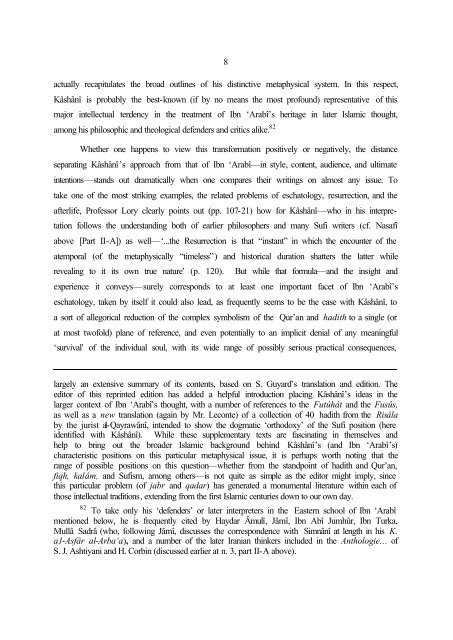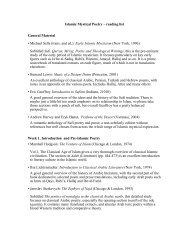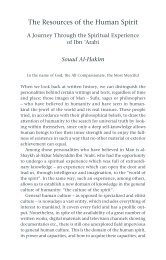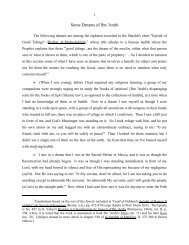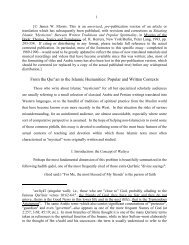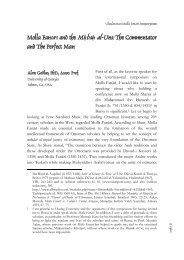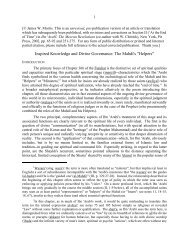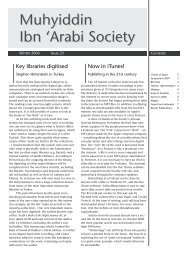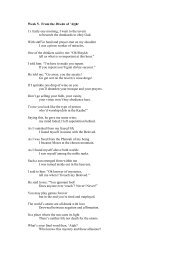Part III (pdf) - Muhyiddin Ibn Arabi Society
Part III (pdf) - Muhyiddin Ibn Arabi Society
Part III (pdf) - Muhyiddin Ibn Arabi Society
Create successful ePaper yourself
Turn your PDF publications into a flip-book with our unique Google optimized e-Paper software.
8actually recapitulates the broad outlines of his distinctive metaphysical system. In this respect,Kâshânî is probably the best-known (if by no means the most profound) representative of thismajor intellectual tendency in the treatment of <strong>Ibn</strong> ‘Arabî’s heritage in later Islamic thought,among his philosophic and theological defenders and critics alike. 82Whether one happens to view this transformation positively or negatively, the distanceseparating Kâshânî’s approach from that of <strong>Ibn</strong> ‘Arabî—in style, content, audience, and ultimateintentions—stands out dramatically when one compares their writings on almost any issue. Totake one of the most striking examples, the related problems of eschatology, resurrection, and theafterlife, Professor Lory clearly points out (pp. 107-21) how for Kâshânî—who in his interpretationfollows the understanding both of earlier philosophers and many Sufi writers (cf. Nasafîabove [<strong>Part</strong> II-A]) as well—‘...the Resurrection is that “instant” in which the encounter of theatemporal (of the metaphysically “timeless”) and historical duration shatters the latter whilerevealing to it its own true nature’ (p. 120). But while that formula—and the insight andexperience it conveys—surely corresponds to at least one important facet of <strong>Ibn</strong> ‘Arabî’seschatology, taken by itself it could also lead, as frequently seems to be the case with Kâshânî, toa sort of allegorical reduction of the complex symbolism of the Qur’an and hadith to a single (orat most twofold) plane of reference, and even potentially to an implicit denial of any meaningful‘survival’ of the individual soul, with its wide range of possibly serious practical consequences,largely an extensive summary of its contents, based on S. Guyard’s translation and edition. Theeditor of this reprinted edition has added a helpful introduction placing Kâshânî’s ideas in thelarger context of <strong>Ibn</strong> ‘Arabî’s thought, with a number of references to the Futûhât and the Fusûs,as well as a new translation (again by Mr. Leconte) of a collection of 40 hadith from the Risâlaby the jurist al-Qayrawânî, intended to show the dogmatic ‘orthodoxy’ of the Sufi position (hereidentified with Kâshânî). While these supplementary texts are fascinating in themselves andhelp to bring out the broader Islamic background behind Kâshânî’s (and <strong>Ibn</strong> ‘Arabî’s)characteristic positions on this particular metaphysical issue, it is perhaps worth noting that therange of possible positions on this question—whether from the standpoint of hadith and Qur’an,fiqh, kalâm, and Sufism, among others—is not quite as simple as the editor might imply, sincethis particular problem (of jabr and qadar) has generated a monumental literature within each ofthose intellectual traditions, extending from the first Islamic centuries down to our own day.82 To take only his ‘defenders’ or later interpreters in the Eastern school of <strong>Ibn</strong> ‘Arabîmentioned below, he is frequently cited by Haydar Âmulî, Jâmî, <strong>Ibn</strong> Abî Jumhûr, <strong>Ibn</strong> Turka,Mullâ Sadrâ (who, following Jâmî, discusses the correspondence with Simnânî at length in his K.a1-Asfâr al-Arba‘a), and a number of the later Iranian thinkers included in the Anthologie… ofS. J. Ashtiyani and H. Corbin (discussed earlier at n. 3, part II-A above).


